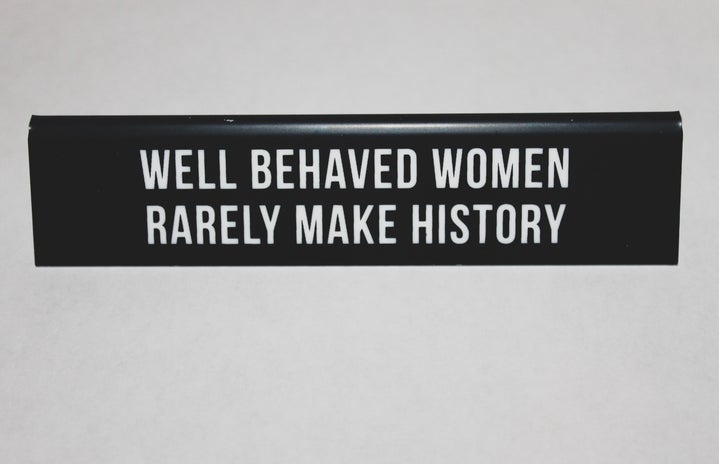I’ve been really into horror recently, mainly for two reasons:
-
It’s spooky season! ????
-
Ready or Not
Ready or Not is not horror in the strictest sense—it’s mostly a thriller comedy with elements of horror, which is the elevator pitch I used to drag my scaredy-cat roommates with me. Don’t get me wrong, it’s not for the faint of heart. It’s incredibly violent, almost exploitatively so, and I probably wouldn’t have kept watching except for the rollicking humor…and Grace. (Wait until the end for a sneak peek of my Halloween costume this year.)
Grace, played by a brilliant Samara Weaving (Saturn Awards, pull through!) is the “final girl” of the film. According to Carol J. Clover in Men, Women, and Chainsaws: Gender in the Modern Horror Film, final girls are defined as, well, the last girl standing. A final girl is most often the last one standing, period, having defeated or outrun the villain by skill or chance. Clover’s definition also includes being virginal or pure and using a masculine-coded object (the villain’s weapon, famously a chainsaw or machete) to defeat the bad guy. But this definition doesn’t really hold up—at least, not to the iconic films of the genre. And not once do you realize that surviving isn’t lesser. In fact, for women, sometimes surviving is heroic. In Ready or Not, Grace signifies the full evolution of the “final girl” from a shrieking, hapless maiden into a fully realized woman who defeats the evil cleverly and resiliently. And it got me thinking. Horror films, and “slasher” films, in particular, are more feminist than we give them credit for. Because this evolution didn’t start with Grace—it started with slashers.
Here are five leading “final girls” who led the way for our newest girl, Grace.
- Sally Hardesty, “The Texas Chainsaw Massacre”
-
The first true slasher film is 1974’s The Texas Chainsaw Massacre, starring Marilyn Burns as final girl Sally Hardesty. TCM isn’t especially feminist, with female characters being brutally and slowly tortured and murdered while men get relatively quick deaths, but it remains one of the most important horror films of all time. But while Sally Hardesty was eating at Leatherface’s dinner table, another final girl was in the making.
- Jess Bradford, “Black Christmas”
-
Black Christmas (due for a remake this December) was released only two months after TCM. But this film did what many others after it would not: its “final girl” isn’t a virgin (Ugh, that sounds so gross, doesn’t it?). Olivia Hussey plays Jess Bradford, a pregnant sorority girl who will do whatever it takes to survive while her sisters get picked off by a mysterious killer. But before she even faces danger, she is having to fight against men: she wants an abortion, and her boyfriend is aggressive and belligerent in response (1974, y’all!).
- Laurie Strode, “Halloween”
-
Next on our countdown is perhaps the defining “final girl” of the 80’s—even, perhaps, of all time. In 1978, Jamie Lee Curtis screamed her way through Halloween as Michael Myers chased her with a machete and mask. Laurie Strode wasn’t as progressive or resilient as Jess and Sally, but she still was the last one standing. By 2018, Curtis had made her way back into Haddonfield in Halloween (2018) set 40 years later. Talk about a legacy!
- Ellen Ripley, “Aliens”
-
Sigourney Weaver’s Ellen Ripley is often brushed off as a false final girl since Alien and its sequel (we don’t talk about the rest of them) are more science fiction than horror. But it still warrants considering that by Aliens in 1986, Ripley had grown from a final girl into a fully realized character. Wracked with PTSD from the events of the first film, she is allowed to be depressed and angry when she has to return to the space station without turning into a shrinking violet. When she realizes a little girl survived the Xenomorph’s attack, Ripley is changed from a callous mercenary to a traumatized mother, and she is changed with great compassion. Protection, rather than necessity or revenge, is her motive, and it makes it that much more satisfying when she says, “Get away from her, you bitch.” Can you tell Ripley’s my favorite final girl?
- Sidney Prescott, “Scream”
-
And then, in the 90s, the genre was revived and changed forever by a veritable horror king: Wes Craven. In 1996, his sharp satire Scream re-popularized horror films after a decade of duds. And Scream’s star is Neve Campbell playing Sid Prescott, another heroine with trauma (this time from her mother’s brutal murder) along with a wealth of knowledge about horror tropes. But just when it seems like Sid might get the ax (or knife) for breaking the number one rule of no sex, Craven turns the tables. This “deconstructionism,” as it was seen at the time, played a groundbreaking role in the history of the final girl and in the history of horror. But it was simply a return to form—it had been 22 years since Black Christmas, and the world had forgotten what a true final girl looked like.
- Grace Le Domas, “Ready or Not”
-
Aside from Paranormal Activity and other early Blumhouse hits, there was a long hiatus of good horror in the 2000s— nevermind good slasher. Even with the so-called “horror renaissance” of the 2010s with Get Out, Hereditary, Us, Midsommar, The VVitch and other indie hits, slasher has been much scarcer, the most popular being Happy Death Day and The Purge. Which brings us to Ready or Not.
Do people get slashed? Sure, a couple. They’re also shot with arrows, smushed in dumbwaiters and strangled with a bridal sash, but Ready or Not carries the most essential element of a slasher: the final girl, in the form of full-circle, postmodern, witty and tough Grace. Is she flawless? No. She smokes, has clearly had sex (a supposed flaw for Clover’s final girl) and curses people out in 30-second streams of pure filth. But she wants a family. She loves her fiancé and she just wants to belong. When she has to go through weird cult ritual to do so, we’re automatically sympathetic—yeah, babe, this is crazy. When she crawls out of a pit full of corpses, we recoil against our seats and feel her revulsion and desperation. And at the end of the film, when she laughs hysterically and sits down for a cigarette covered in her own blood and her in-laws’, we get it. Sh*t happens, girl.
Since that original 1992 definition, final girls have changed drastically in tandem with the social climate. In ‘78, people rolled their eyes at Laurie Strode shrieking and flailing down the street away from Michael Myers. In ‘96, people sat back in shock when Sid Prescott shot her pursuer in the chest. In 2019, people let out shaky laughs and sighs of relief when Grace sat down and lit a cigarette. And I, for one, can’t wait to see who comes next.



